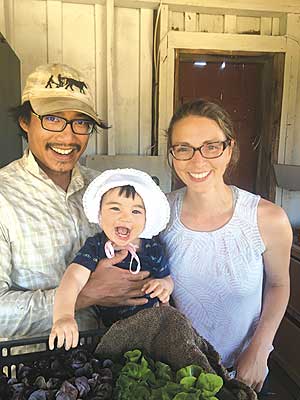 |
| Richard Lee and Kate Del Vecchio with their daughter, Samara. Photo courtesy of Tender Soles Farm |
By Richard Lee
The day before writing this, I spent what I thought would be a leisurely Sunday on a forecart driving my team 4 miles down the road to pick up a free horse-drawn hay loader. I had gone over in my mind a few times what I was setting out to do, as I usually do with any kind of horse work, but I realized too late that I had not thought through the return trip: the implement new to the horses, the noise it might make, the new environment we were traveling through together.
I surely had plenty of time to think about it on the 40-minute trip down, but later I had a momentary lapse in judgment that set off a series of potentially dangerous – lethal, even – events. The horses took off with the loader because they weren’t given enough time to acclimate to it, especially in a new environment. Fortunately the pin connecting the loader to the forecart came out before they left the driveway, dropping the loader, and the team ended up splitting themselves around a tree – one horse somehow totally removing all of his harness except his bridle. I was lucky that a former-teamster friend, notified by the neighbor who was giving me the loader, showed up just after our little runaway happened; lucky that neither the horses, nor I, nor the equipment really got hurt. We repaired what was needed to get home with little more than a broken hame strap and my bruised ego.
I can chalk up the mishap to the tired haze of vegetable farming in July, being in the throes of raising a 1-year-old with all its fun and lack of sleep, running a business, the heat, developing a working relationship with a new horse, and over-trusting the horses with whom I work three or four days a week in field and forest. However, a momentary lapse in judgement is all it really takes to get into a dangerous situation when farming or logging. The same can be said of many occupations, but according to the U.S. Bureau of Labor Statistics, farming, fishing and forestry had the greatest fatal injury rates of any occupations in 2014 and 2015 (www.bls.gov/news.release/cfoi.t03.htm). I have somehow chosen to participate in two of the three.
Those who choose to work in these occupations do so for many reasons. The people I know who log and farm on a small scale, particularly with draft horses, do so because we love the process, the holistic relationships, nature, and using our minds and bodies in concert to carry out the basic human act of harvesting for consumption – in other words, maintaining sovereignty over our physical and spiritual wellbeing. We are a deliberate, thoughtful group who want to do right by the environment, and by our children and grandchildren. We work with draft animals because we like to smell, hear, see and feel the environment under our feet at a human pace.
I do not want to romanticize what I do. Trying to make a living growing food and harvesting firewood and lumber from the land is hard enough. Incorporating horses as the primary source of draft adds a challenge. It’s slower than fossil-fueled machines, requires more specialized equipment such as harness and carts, and can reveal a lot – positive and negative – about yourself as a person. Draft animals are also lighter on the land, renewable and solar-powered, smell good and are art/athletes in motion. You can appreciate a salad or a woodshed a lot more when you see how much muscle, hay calories and skill the horse needs in order to accomplish the work you intend for it to carry out.
Sometimes I wish the work went faster, but I would lose the intention that goes into every calorie of movement to create our food and lumber. When you lose intention and translate the life of a plant into dollars, you lose the meaning of the relationships between plant, animal, fungus, bacteria, air, water and soil.
I challenge anyone to gain intimate knowledge of his or her land through the tires on a car or four-wheeler. You move too fast to see, hear and smell anything. You’re gone before you can see which way the light hits those trees, fields and slopes so that you can maximize the growing potential. You move too fast to even see the tracks you’re leaving, and too noisily to hear the difference in the soil or the birds and trees you are disturbing. You lose some subtlety and you cannot pay close enough attention to see the cascade of events your actions have until you have that momentary lapse of judgment with a potential catastrophe written all over it. Even with the slower pace of horses, I can miss one or two things in the midst of the “go, go, go” parade of thoughts associated with market gardening.
I don’t wish to scare anyone from farming or logging with horses. It is a challenging yet rewarding way of life. Perhaps that is my point. The way we choose to farm is ingrained in the daily rhythms of horse chores, pasture management, grooming, harnessing, hoof trimming and equipment management on top of whatever else we might be doing – raising vegetables and livestock, raising a family, and nourishing our bodies with good food and sleep. Yes, we also aim to make money to sustain ourselves, but the real rewards are the products of dedication, planning, sweat and sore muscles. The real results look like a healthy farm ecosystem and healthy farmers.
About the author: Richard Lee and his wife, Kate Del Vecchio, own MOFGA-certified organic Tender Soles Farm in Richmond, Maine. They are former MOFGA apprentices.
